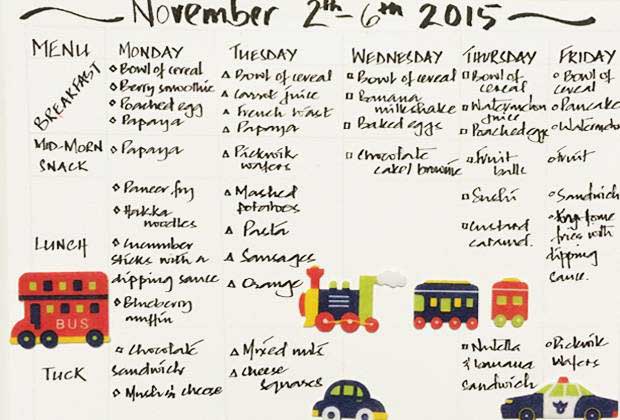Kiddie Delights: How To Manage The Lunchbox Madness
- By Rashmi NaikLoading...
- | 13 July 2016 4:58 PM IST
 X
X
 A weekly menu is a great idea to get started.
A weekly menu is a great idea to get started.
Picture this. It’s 5 am and you snooze the morning alarm only to realise it is not a Sunday. You start walking to the kitchen sleepy-eyed, and for a split second your mind goes blank. The question is - what do you make for the kid's lunchbox today?
And then in a series of flamenco-meets- breakdance movements, you swirl from the vegetable rack in the refrigerator to the pantry overflowing with cans and packets. After the meaningless exercise, you realise that you are either spoilt for choice or have barely two options, which ends up in the same conundrum – you still don’t know what to pack for the lunchbox!
To add another dimension, you also have breakfast to prepare. As the deadline looms, you scramble up some leftovers in the child’s and hubby’s lunchboxes. Once the little one clambers into the school bus, you regret, which is often tinged with guilt and painted with dread. Will that lunchbox come back as is with just a morsel or two missing, or miraculously clean?
Mothers and those precious few dads out there who are entrusted with this thankless task of preparing lunchboxes, I have found a sure-shot way of bypassing large parts of the scenario that just played out. Provided you take the effort of engaging your children in this exercise, I assure you these tips will make the entire process fun and satiating for you and your little ones.
No, it is not as hard as it seems.
PLAN THE MENU FOR THE WEEK - YES, THE ENTIRE WEEK
Democratise the process: Pick a 10-minute slot with the jingbang over the weekend, preferably before you go on your weekly shopping to discuss the menu for the week with them. Make a few suggestions, but let them choose what they would like for each meal. Nudge them to pick the right thing. For instance, if you want them to eat an egg every morning for breakfast, then let them choose whether they would like it boiled, fried or scrambled. It is a delicate balance when you are trying to give a child the impression that he or she is getting a chance to decide.
Try not to complicate things: Don’t get too ambitious but at the same time don’t limit the menu to just one kind of food. I know children who eat just rice and sambhar or just pasta and nothing but pasta. Your menu must be diverse and yet simple. Plot your meals by type and day, and try to bring in some variation. Ideally, you should eat
the same food you pack for the kids. You are responsible for developing their taste buds.
Display the menu in a prominent spot: The door of the fridge should work well. Ask them to add some colour and sparkle onto the menu. And if there are any protests on the table, without raising your temper or voice direct them to the menu that ‘they’ put together. Watch how quickly the voices of dissension subside.
 Happy lunchboxes make for happy kids! Photo: Rashmi Naik
Happy lunchboxes make for happy kids! Photo: Rashmi Naik
MANAGE INVENTORY - BEFRIEND CHECKLISTS & THINGS-TO-DO LISTS
Once your menu is in place, you will notice how easy it is to put together your shopping list. You will also realise fairly quickly, how a simple list can save considerable amounts of time and money. Stick to buying what is on your shopping list.
SET REALISTIC GOALS & TIMELINES
Prep work is crucial. If you have sushi on your menu, cook the rice and keep it in the fridge to cool overnight. Also remember to keep your ingredients handy. You should not spend more than 2 minutes looking for a bottle of mayonnaise. For patty or cutlets, boil the potatoes the night before or use the microwave to save time. Avoid pasta sauces that come in jars or bottles, making a mean pasta sauce is not as time consuming as Heinz would like us to believe it is. Chinese food takes relatively lesser time to make compared to Indian food, so pick that cuisine on a day when you have an early morning team meeting at work. Give yourself a minimum two hours from the time you start cooking to the time you and/ or your child needs to head out of the house.
LESS IS MORE
You don’t need an array of fancy gadgets in the kitchen. A food processor, an oven or microwave, a good cast iron or non-stick pan, a colander and a couple of pots should suffice. Keep the lunchboxes and packaging material handy. The act of unwrapping a neatly-packed sandwich is highly underrated, or opening a box with two black olives as eyes with a sliver of red bell pepper to resemble a smile is almost always appreciated.
FEEDBACK IS A GIFT
Ask your child how he or she liked the lunch – was the quantity too much, was the texture right, was it too salty or sweet. Make mental notes, did they like the Thai curry with rice vermicelli or the cottage cheese in teriyaki sauce. By receiving feedback, you will get ideas for next week’s menu.
The author is a working mum-of- two. When she is not drafting a marketing or communications plan, you can find her writing about food and parenting or reading books on food, fiction and fact.
Follow her on Twitter @RashmiRNaik



